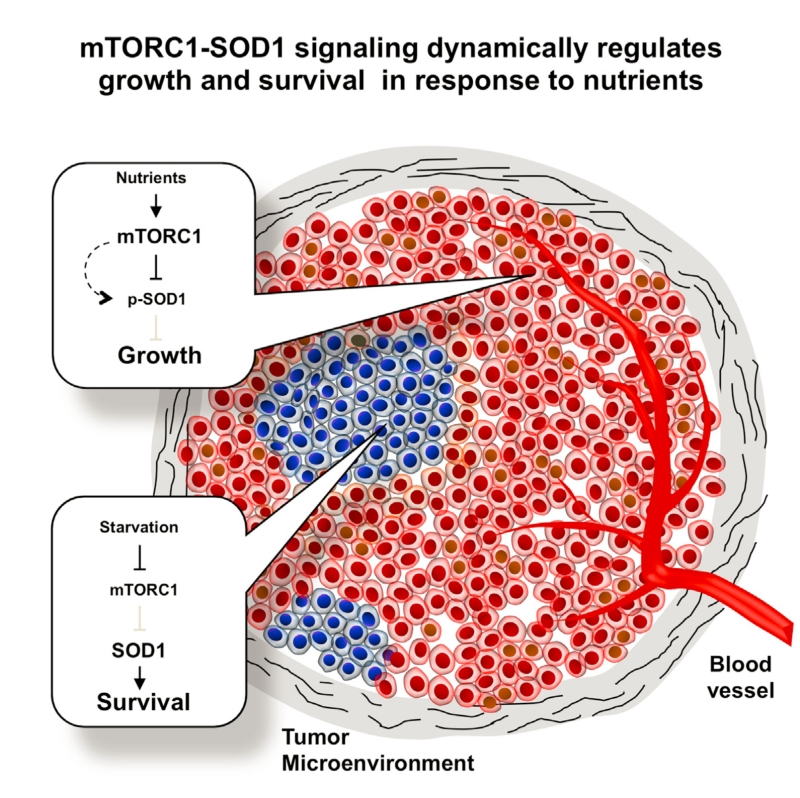當(dāng)前位置:首頁 > News
Tsang’s research team of the Clinical Neuroscience Institute, the First Affiliated Hospital of Jinan University published an article in Molecular Cell
發(fā)布者:系統(tǒng)主管 發(fā)布時間:2018/05/30
Tsang’s research team of the Clinical Neuroscience Institute, the First Affiliated Hospital of Jinan University published an article in Molecular Cell
Professor Chi Kwan Tsang (Calvin) has recently published an article entitled “SOD1 Phosphorylation by mTORC1 Couples Nutrient Sensing and Redox Regulation” in the top-tier journal Molecular Cell (impact factor=14.714) (Molecular Cell, 2018, 70, 502-515). This paper reported an important novel mechanism by which mTOR signaling regulates redox homeostasis and cell growth under dynamic nutrient conditions.


DOI: https://doi.org/10.1016/j.molcel.2018.03.029 Published 3rd May, 2018
Nutrients are not only organic compounds fueling bioenergics and biosynthesis, but also key chemical signals controlling growth and metabolism. Nutrients enormously impact the production of reactive oxygen species (ROS), which play essential roles in normal physiology and diseases. How nutrient signaling is integrated with redox regulation is still an open question in the field of Cell Biology, although mechanistic target of rapamycin (mTOR) is well-known to be a key nutrient sensor for the regulation of cell growth. In this article, Tsang’s group reported that superoxide dismutase 1 (SOD1) is a conserved component of the mTORC1-nutrient signaling. mTORC1 regulates SOD1 activity through reversible phosphorylation at S39 in yeast and T40 in humans in response to nutrients, which moderates ROS level and prevents oxidative DNA damage. They further show that SOD1 activation enhances cell survival in the ischemic microenvironment. Collectively, these findings identify a conserved mechanism by which eukaryotes dynamically regulate redox homeostasis in response to changing nutrient conditions.
The unicellular organisms (like the budding yeasts) can regulate growth rapidly in response to nutrient availability in the surrounding environment. In contrast, higher organisms (like humans) acquire relatively stable supply of nutrients from the circulatory system. However, focal ischemia due to blockage of blood vessel will lead to the deprivation of oxygen and nutrients in the the ischemic tissues, which is a major cause of heart diseases and ischemic stroke. In addition, dysregulation of nutrient-mediated growth signaling is closely associated with numerous human diseases such as cancer, diabetes and obesity. Professor Tsang’s research team discovered a crucial molecular mechanism which will provide important insight into the novel therapeutic strageties for the treatment of these diseases.
This ground-breaking discovery is achieved through an international collaboration consisting of investigators in the Clinical Neuroscience Institute, the First Affiliated Hospital of Jinan University, the Cancer Institute of Rutgers Univetsity in USA and the Cancer Center of Sun Yat-Sen University. This article was selected as the Feature Article published in the 3rd May 2018 issue of Molecualr Cell. In addition to the Editor’s note, this article was commended in a Preview Article by an expert in the field. Professor Tsang was also invited to have a personal interview in the “Meet the Author” section of the journal. This study laid a solid foundation for Professor Tsang’s current research works on the cerebrovascular protection against ischemic stroke. Please contact Professor Tsang at tsangch(AT)jnu.edu.cn for research opportunity (undergraduate included) in his laboratory.
Article link: https://www.cell.com/molecular-cell/fulltext/S1097-2765(18)30232-6
Preview Article link: https://www.cell.com/molecular-cell/fulltext/S1097-2765(18)30311-3
“Meet the Author” link: https://www.cell.com/molecular-cell/meet-the-author/chi-kwan-tsang

 粵公網(wǎng)安備 44010602002443號
粵公網(wǎng)安備 44010602002443號


